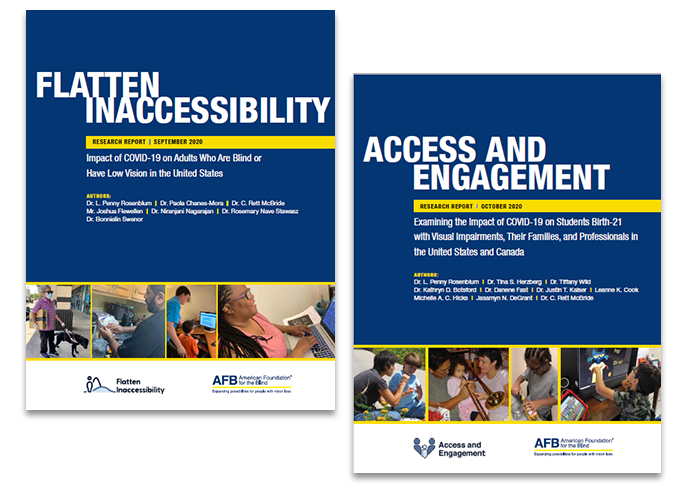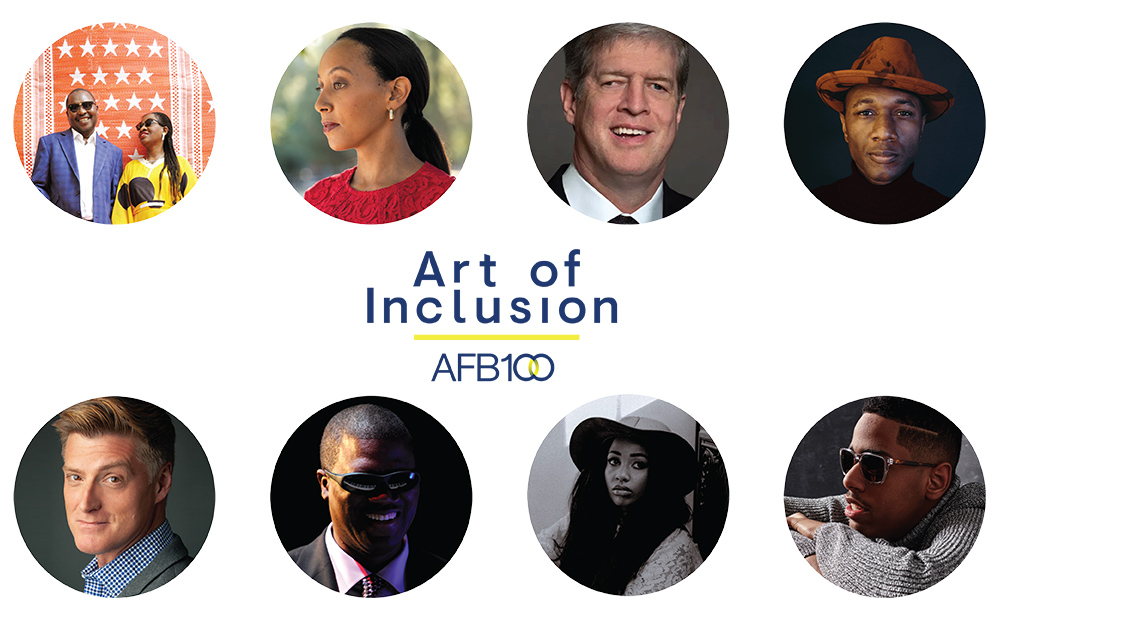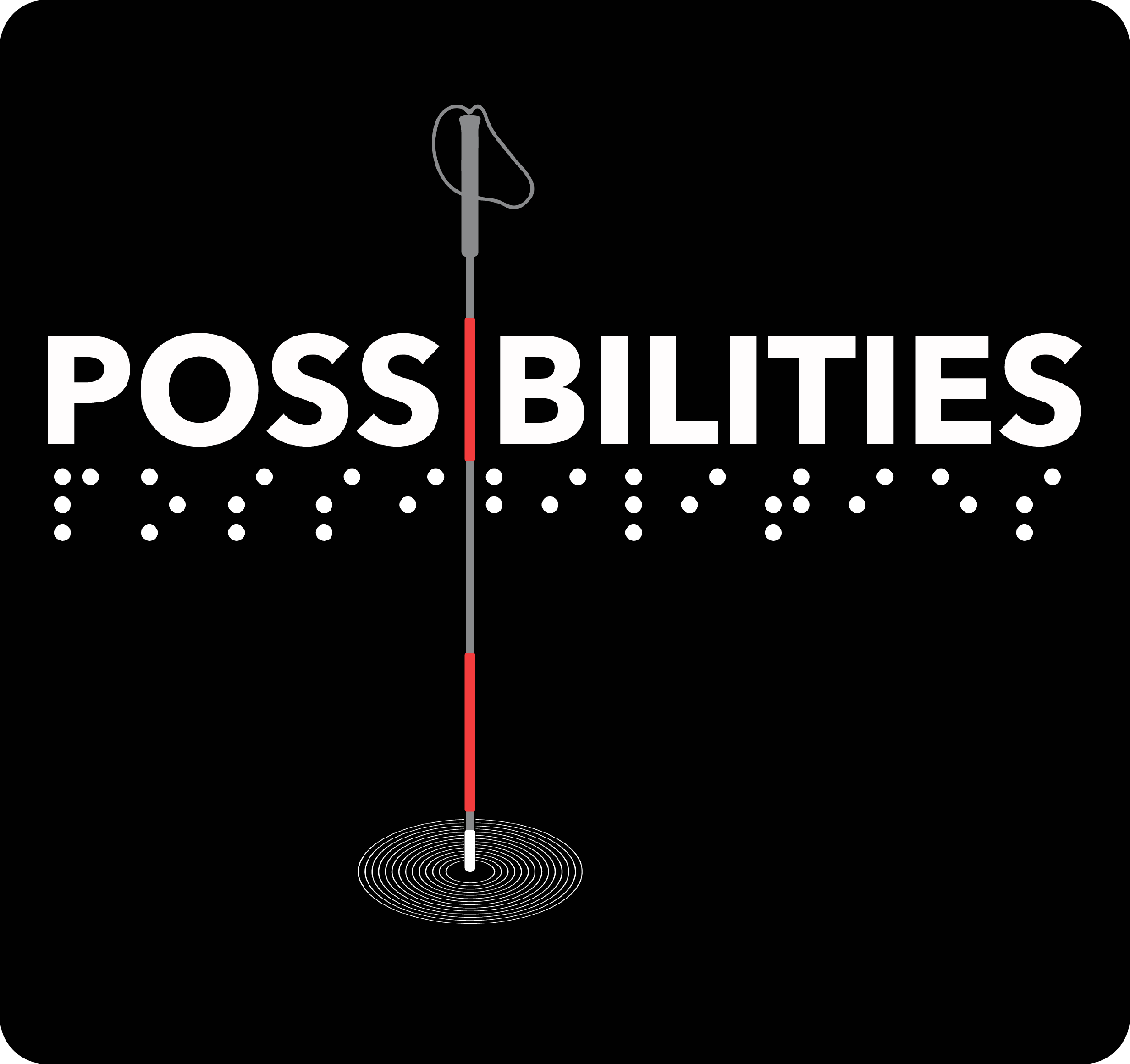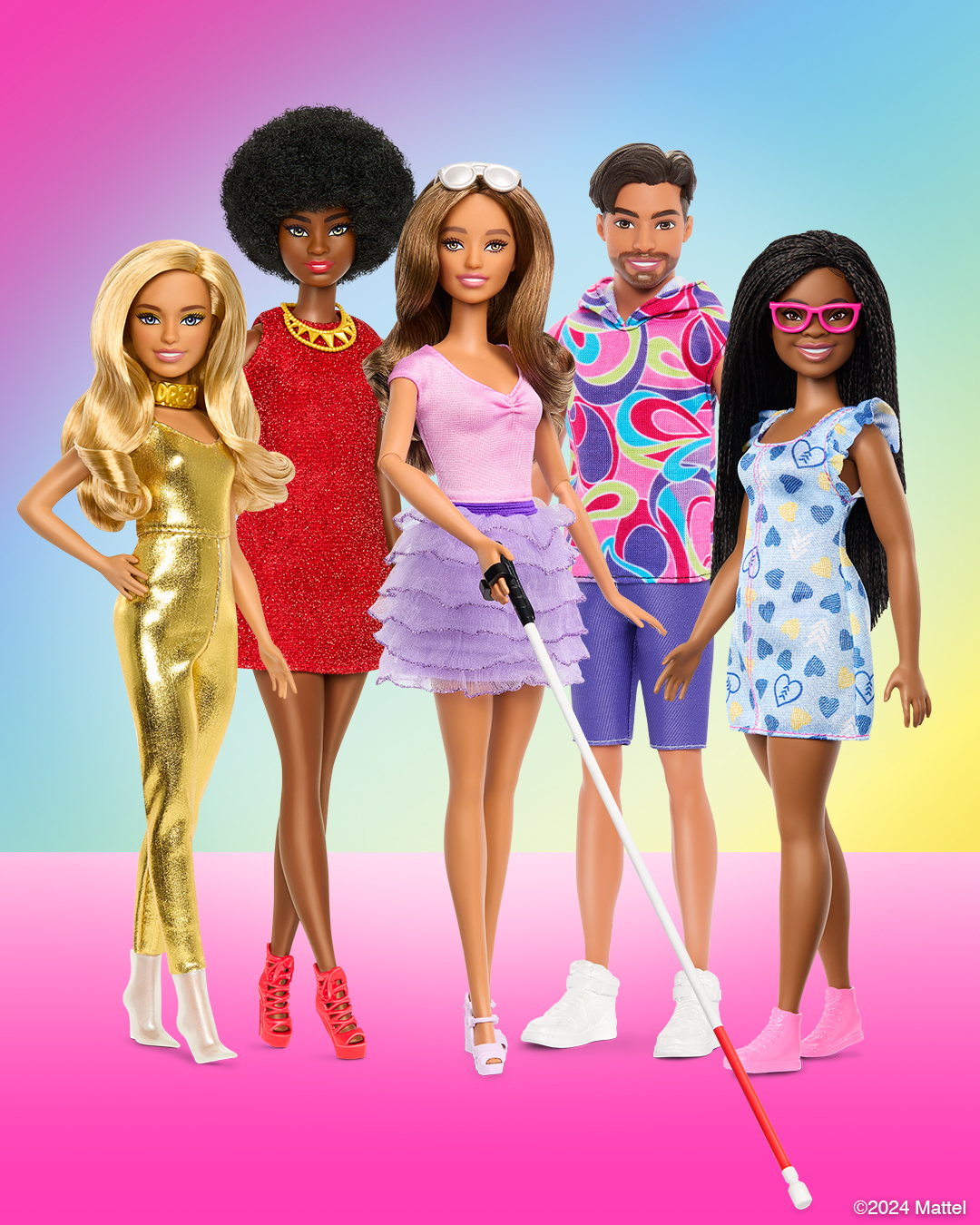1920s
"He who is content with what has been done is an obstacle in the path of progress."
Helen Keller, 1927

Soldiers blinded in World War I reading brailled literature, 1920.
September 23, 1921
AFB is founded to help blinded veterans returning from World War I, with support from American philanthropist M. C. Migel.

Cover of Outlook for the Blind, December 1925.
1923
AFB becomes publisher of Outlook for the Blind. In continuous publication since 1907, the leading research journal of record for the blindness field has been known as the Journal of Visual Impairment & Blindness since 1977.

Robert B. Irwin, AFB executive director, 1929-1949. (1950, Copyright Seattle Times Co.)
1923
AFB hires Robert B. Irwin as our first executive director. Blind since the age of 5, Irwin's relentless work led to significant advances in education for children who were blind.
"He wants this Foundation to stand like a Gibraltar through the years."
A reporter talking about M. C. Migel, AFB's first President, 1924

Portrait of Helen Keller, circa 1925
1924
Helen Keller, author, activist, and advocate, joins AFB as its champion. Keller travels the United States, advocating for the expansion of rights and services for blind Americans. She speaks in front of state legislatures, demanding the creation of state commissions for people who are blind. In 1921, only 17 states had "legislative provisions for constructive services for the adult blind." By 1941, all but three states and the District of Columbia had created some form of provision.
1924
"I hope one day to see enough braille presses, libraries, schools, and training centers and teachers to assure all persons the opportunities they would have had, had they not been blind. This is my greatest purpose in life."
Helen Keller, AFB greeting card, Christmas appeal, 1964

Helen Keller presents a radio to a blind child, as a reward for earning high marks in her studies. Circa 1925.
1924
AFB distributes radios to citizens who are blind, giving them firsthand access to breaking news—a game-changer in leveling the playing field for people who are blind.
1924
"I think of the radio as a wonderful voice from the outside world which binds closer together those who see and those who cannot see—as a messenger of sympathy and aid, a consoler of the lonely, an enlarger of the common life, a carrier of news and knowledge, a scatterer of sunshine."
Helen Keller to Atwater Kent, March 1929, asking for a donation of radios
1926
AFB creates a nationwide Directory of Services for people with vision loss. Now available online, the Directory remains an indispensable resource.
1927
AFB collaborates with the Perkins School for the Blind to create evidence-based teaching methods for educators of children with visual impairments. The program is implemented by the Perkins School for the Blind and Harvard University.
1927
"Education should train the child to use his brains, to make for himself a place in the world and maintain his rights even when it seems that society would shove him into the scrap-heap."
Helen Keller, "Going Back to School," The Home Magazine, 1934
1930s
"With the stroke of the pen you have released the blessing of the talking-book—the most constructive aid to the blind since the invention of Braille which opened to them the doors of education."
Helen Keller to Franklin D. Roosevelt, November 2, 1935

Delegates stand outside the White House on the occasion of the first World Conference on Work for the Blind, 1931. Front row, left to right: Ian Fraser (holding hat), Robert B. Irwin, unidentified, Anne S. Macy, Helen Keller, President Hoover, and Mrs. Hoover.
1931
Delegates from 32 nations gather for the first World Conference on Work for the Blind in New York City. The meeting establishes AFB's national and international prominence.
March 3, 1931
M. C. Migel, Robert B. Irwin, and Helen Keller testify before Congress in 1930 in support of a bill to provide braille books to blind adults. The bill is signed into law March 3, 1931, making books available in libraries around the country.
March 3, 1931
"Literature is my Utopia. Here I am not disenfranchised. No barrier of the senses shuts me out from the sweet, gracious discourse of my book-friends. They talk to me without embarrassment or awkwardness."
Helen Keller, The Story of My Life, 1902
1932
AFB works side by side with the National Institute for the Blind in London to establish a uniform braille code throughout the English-speaking world.
Works Progress Administration video demonstrating the construction of Talking Book machines and the recording of Talking Book records at the American Foundation for the Blind, circa 1932. Courtesy of the Sherman Grinberg Film Library. View WPA Aids the Blind transcript.
1932
AFB pioneers the Talking Book. Today known as the audiobook, it paved the way for today's accessible technology.

Young woman types using an AFB-updated braille typewriter manufactured by L. C. Smith & Corona, 1933.
1933
AFB develops a new portable braillewriter, expanding employment opportunities for people with visual impairments.

Front page of the The New York Times, December 2, 1934, announcing laying the cornerstone of the new AFB headquarters in Manhattan, NYC. From The New York Times. © 2021 The New York Times Company. All rights reserved. Used under license. Read the transcript of the 1934 article.
December 5, 1934
AFB's New York City headquarters are featured on the front page of The New York Times.
November 2, 1935
Helen Keller writes to President Roosevelt thanking him for his support.
1938
The Wagner-Lewis Bill, also known as the Social Security Act, is introduced into Congress with provisions for other disabilities, but none for blindness. AFB staff successfully fight for inclusion of blind and visually impaired Americans. The Wagner O'Day Act passes in 1938, radically improving employment opportunities for people with vision loss. This law requires the federal purchase of blind-made products.
1939
AFB invests in racial equity through teacher training programs in the South for blind and deafblind children in Black communities
1940s
"Humanity is badly patched; but it is made of lasting material."
Helen Keller, undated

A blind veteran receives a gift of a tactile braille watch, 1944.
1943
AFB invests in research and laboratories to develop new technology to support blinded WWII veterans. This includes a special consultation service for the more than 1,600 veterans of that conflict, providing each with a braille watch and other equipment not then available from the federal government.

A woman using a sewing machine, circa 1944. The smaller image provides a close-up of the attachment that makes the machine accessible.
1944
Inauguration of a research laboratory where AFB creates and distributes assistive devices, such as hearing aids, a blood pressure device, a bill denomination detector, and a vibrating alarm clock. By the end of the decade AFB has distributed over 30,000 devices.

Helen Keller and Polly Thomson with amputees at a U.S. military hospital, possibly McCloskey General Hospital, Temple, Texas, 1944.
1944
Helen Keller visits more than 90 U.S. Army hospitals during World War II. This AFB initiative continues through the Korean War.

President Harry S. Truman, standing next to AFB’s Irvin P. Schloss, presents the Official Insignia of the Blinded Veterans Association, Inc., to the executives of the organization. April 12, 1948. Courtesy of the Truman Library Archive. Copyright © UPI.com.
1945
In partnership with the Veterans Administration, AFB establishes the Blinded Veterans Administration to ensure soldiers returning from war have access to rehabilitation services. M. C. Migel, AFB's president and CEO, donates $10,000 for its establishment.
1948
AFB creates a governmental relations office in Washington, D.C., to ensure a permanent presence on Capitol Hill and to monitor all federal activities with an impact on blindness and related issues. In 2017, AFB moves its headquarters from New York City to Washington, D.C.
Helen Keller and Polly Thomson in Japan in 1948. View the transcript for "Helen Keller Visits Japan."
1948
Helen Keller travels to Japan as the United States' First Goodwill Ambassador after World War II. Between 1930 and 1957, Keller travels to 39 countries around the globe, advocating on behalf of those with vision loss.
1950s
"Never have I seen such a sturdy spirit of interscience cooperation as I did between you[r] representatives of psychology, medicine, chemistry and engineering. "
Helen Keller visits the Massachusetts Institute of Technology and inspects technology to assist people who are deaf, 1950
1951
AFB creates a department devoted to the welfare of preschool-age children in response to increasing concerns over the rise in infant blindness as a result of retrolental fibroplasia (RLF). First identified in 1938, RLF was caused by too much oxygen administered to premature babies.

An excerpt of the newspaper comic strip Rex Morgan M.D., providing the general public with information about blindness, circa 1955. Read full transcript of Rex Morgan M.D.
1952
AFB generates greater awareness of blindness through TV, print, and radio campaigns.
Helen Keller in Connecticut and Paris on the occasion of the 100th anniversary of the death of Louis Braille. View transcript for Helen Keller in Paris.
1952
Helen Keller speaks in Paris, France, on the centennial of Louis Braille’s death.
1952
"In our small way we the blind are as indebted to Louis Braille as mankind is to Gutenberg…the raised letters under our fingers are precious pods from which has sprouted our intellectual wealth."
Helen Keller, June 21, 1952, Paris, France

Testing and demonstration of an electric braillewriter by Helen Keller at the American Foundation for the Blind in New York City, 1954. Seated left to right in the Helen Keller Room: an unidentified man, M. Robert Barnett (AFB’s executive director), Marta Sobieski, Peter J. Salmon (executive director of the Industrial Home for the Blind, Brooklyn), Helen Keller, Polly Thomson, and Gregor Ziemer.
1952
AFB develops breakthrough communications technologies, including the Tellatouch machine enabling people who are deafblind to communicate. AFB's new research laboratory develops the Megascope, a magnifying device and the precursor to closed-circuit television.
1955
AFB co-sponsors with Louisiana State School for the Blind the first regional workshop on curriculum improvement in residential schools serving Black children.
1955
"...the Foundation hopes that future service for the young Negro blind may be strengthened, leading toward the ideal of equality of opportunity."
AFB Annual Report, 1952-1953
Anne Sullivan Macy demonstrates how she taught Helen to speak, circa 1924. View transcript for Helen Keller and Anne S. Macy clip.
1955
Helen Keller in Her Story, a documentary commissioned by AFB, wins the Oscar for Best Documentary Feature film.
1960s
"We differ, blind and seeing, one from another, not in our senses, but in the use we make of them, in the imagination and courage with which we seek wisdom beyond our senses."
Helen Keller, AFB Annual Report, 1961-1962
1962
AFB becomes a world clearinghouse for information on blindness, hosting an international conference in New York City on technology and blindness and launching a worldwide information exchange program. This leads to the creation of the International Research Information Service (IRIS), which enables researchers in all parts of the world to learn of progress being made by their fellow scientists.

Edwin R. Skinner, a machinist who is blind, stands holding a piece of lathe equipment, circa 1967.
1964
AFB improves workplace devices, expanding employment opportunities for people with vision loss. For example, auditory levels assist blind carpenters and bricklayers.
1965
AFB begins testing an electronic speech compressor based on designs donated by Bell Telephone Laboratories, to double the rate of speech without distortion and enable a blind person to assimilate factual material at a faster rate. This technology is an important precursor to modern screen readers.

Blind schoolchildren study in a resource room at the Alice Drive School, Sumter, South Carolina, circa 1961.
1966
AFB establishes the National Accreditation Council (NAC) to ensure uniform educational services and standardized teaching practices for children with visual impairments. Educational standards and curricula are developed that agencies and schools can follow nationwide.

Cover of The New Outlook for the Blind, May 1974 special issue on planning sex education programs for children and youth with visual impairments.
1969
The Journal of Visual Impairment & Blindness publishes its first special issue, which is now an annual tradition. The June 1969 special issue focuses on aging and blindness. Subsequent special issues cover topics such as being blind and being a woman, career education and employment, computers, cultural diversity, deafblindness, low vision, orientation and mobility, physical fitness, and sex education.
1970s
"In an age when the ability to work is regarded almost as a test of social dignity, it is a sad waste to let a capable blind man or woman be forced to endure idleness—and idleness is the cruellest [sic] part of any handicap. Dear friends, I beg you to do what you can to give all the blind who can be trained the assistance that may lead them to independence."
Helen Keller speech in Finland, 1957.

AFB advertisement for Talking Books on cassette tapes, circa 1993
1970
AFB begins transitioning Talking Books from records to tape cassette technology. The last hard disc was pressed in 1986, by which time AFB had produced 37 million discs.

Author Maya Angelou records her book I Know Why the Caged Bird Sings in a recording booth at the American Foundation for the Blind, 1970. View transcript of I Know Why the Caged Bird Sings
1970
Maya Angelou reads from her book to record I Know Why the Caged Bird Sings.

A Vietnam War veteran who is blind works in his auto repair shop, circa 1972.
1973
AFB invests in research to identify the needs of blinded veterans returning home from the Vietnam War.

Three young girls with visual impairments playing. AFB Annual Report, 1977-1978.
1975
AFB plays a major role in the passage of legislation, known as IDEA, that creates comprehensive curriculum guidelines and ensures that children who are blind or have low vision are mainstreamed into the U.S. public education system. Until this time, more than 90% of blind and visually impaired students were taught in residential schools.
1975
"Just as the Talking Book opened up a whole new world of reading to blind persons, now radio is fulfilling its promise to blind persons by finally making available to them on a day-to-day basis such timely materials as newspapers and weekly news magazines, as well as the grocery ads and even the movie times."
William Gallagher, AFB Executive Director
1977
AFB partners with AT&T to examine best practices for hiring and retaining blind talent.
1978
AFB develops a prototype electronic paper money identifier and a talking thermometer. By this time AFB is the largest distributor in the world of aids and appliances for people who are blind and visually impaired.
1980s
"...the tiny silicon chip will rank with the ideas of the Enlightenment as a liberator of blind and visually impaired persons..."
AFB's 1981-1982 Annual Report accurately predicts the potential for computer technology to be a game-changer for people who are blind.
June 23, 1980
Celebrating the centennial of Helen Keller's birth, AFB hosts the largest meeting ever held on blindness and the needs of people who are deafblind. The week-long conference is attended by 2,500 professionals, volunteers, and consumers, as well as 90 developers and manufacturers of electronic aids, and representatives of 22 associations and organizations.

A young girl sits on a woman's lap at a Families Connecting with Families event, 2012.
1980
Two years of study and discussion on the needs of parents of visually impaired children culminates in the establishment of the National Association of Parents of the Visually Impaired (NAPVI) the first national organization of its kind. Together, AFB and NAPVI create a website called FamilyConnect.

Carrie Canady, 71, and her husband Todd, 85, outside their home in Dallas, Texas, circa 1984.
1980
AFB works to address the needs of blind and visually impaired persons in Latinx, Black, Asian, and American Indian communities. This includes planning an in-service training conference on blindness in partnership with the Navajo Nation in Arizona.
1982
In the early 1980s, the federal budget slashes funds for blindness programs. This leads AFB to appoint regional consultants to work with state legislators to protect programs for blind residents in communities across the country.
1982
"Our regional and newly-appointed community consultants have traveled from state to state and from community to community to testify before legislative bodies and to organize coalitions of consumers, professionals and civic leaders, as well as to explore and solicit new avenues of financial assistance from local sources."
William F. Gallagher, AFB Executive Director

A man reads magnified text on a computer monitor at the AFB National Technology Center, circa 1985.
1986
At its offices in New York City, AFB opens the National Technology Center, the first facility of its kind in the nation to provide research and development, evaluation of devices like talking calculators and large-print display systems, and database services under one roof.
1986
AFB establishes the Careers & Technology Information Bank (CTIB), an information source on assistive technology in the workplace. The CTIB members serve as mentors to students and adults seeking employment. The CTIB later becomes CareerConnect.
1987
"[AFB] worked with organizations such as the National Association for Parents of the Visually Impaired in advocacy efforts for the enactment and implementation of federal legislation that ensures quality education and other services for blind and visually impaired children and youth."
AFB Annual Report, 1987-1988
1988
AFB and Descriptive Video Services successfully lobby Congress to authorize funding of described video.

Volunteer "B.J." Bonny Batty assists students Amber Morgan (left) and Aaron Pina at the Ramses "Touch to See" exhibit in Dallas, circa 1989.
1989
In order to ensure equal access to cultural institutions, AFB publishes best practices for making museums and botanical gardens inclusive. This publication underscores that blind and visually impaired people also enjoy art and culture.
1990s
"For the first time, the communication barriers which blind and visually impaired people face were addressed in a federal law. Access to information had become a civil right."
American Foundation for the Blind on the passage of the Americans with Disabilities Act, July 1990.

President George H. W. Bush signs the Americans with Disabilities Act. With him are Evan Kemp, Justin Dart, Reverend Harold Wilke and Swift Parrino.
1990
President George H. W. Bush signs the landmark civil rights law, the Americans with Disabilities Act. This legislation prohibits discrimination against individuals with disabilities in all areas of public life. Two years earlier, AFB championed the introduction of this bill in Congress, and under the guidance of our Governmental Relations staff, AFB played an active role on the steering committee within the Consortium for Citizens with Disabilities that was one of the driving forces in the passage of the act.

Latanya Shelton and her father Ronald Shelton, Oakland, California. AFB Annual Report, 1994.
1990
AFB successfully rallies educators, parents, and professionals to keep braille in the school systems.
1990
"Literacy—the ability to read and write independently—is a right that should be within reach of all American citizens whatever the reading medium. AFB is working to guarantee that right for all people who are blind or visually impaired."
Carl R. Augusto, AFB President and Executive Director
1990
AFB co-sponsors the first international conference on AIDS-related vision loss in San Francisco, made possible by the Robert Wood Johnson Foundation.
1991
AFB creates the ADA Consulting Group to advise businesses and governmental agencies on how to make their public accommodations and communications systems accessible, including with the use of braille signage.

Graciela Lecube in the AFB Talking Books studio.
1992
Argentinian actress, writer, and Talking Book narrator Graciela Lecube reflects on the importance of AFB's decades-long recordings in Spanish, French, Italian, Portuguese, and German. "People who come here from other countries often live in communities where their native language remains their primary language. For those who are print handicapped, there is very little recorded material available. The work we do in foreign languages provides some measure of choice in what to read. But more important, it provides the enjoyment and learning that comes with having access to a variety of literature."
1993
At the FAO Schwarz toy store on Fifth Avenue in Manhattan, AFB and Toy Manufacturers of America launch a guide that provides examples of toys and games that children with visual impairments might enjoy.

Musician Ray Charles receives the Helen Keller Achievement Award, 1994.
1994
Musician Ray Charles receives the Personal Achievement Award at the first Helen Keller Achievement Awards.

A 12-year-old student attending a NYC public school is sitting in a wheelchair.
1995
AFB publishes its groundbreaking Hand in Hand series, which provides curricula and materials for teachers and educators of children who are deafblind and have multiple disabilities. This is funded by the U.S. Department of Education's Office of Special Education, Severely Handicapped Branch.

Erik Weihenmayer, with three of the other climbers on his team, at the summit of Mt. McKinley, June 27, 1995.
1995
On June 27, 1995—the 115th anniversary of Helen Keller's birth—the AFB HighSights '95 expedition team, including blind English teacher and wrestling coach Erik Weihenmayer, reaches the 20,320-foot summit of Mt. McKinley. Upon reaching the summit, the climbers unfurl the AFB flag.
1995
"...the message of AFB HighSights '95 is universal, extending well beyond blindness. It inspires all of us to realize our potential."
Senate Majority Leader Robert Dole, delivered on the floor of the U.S. Senate

Musician Stevie Wonder receives the Helen Keller Achievement Award, 1996.
1996
Musician Stevie Wonder receives the Helen Keller Achievement Award.

Celebrating the launch of its website, AFB's web address and logo are featured on the cover of the 1996 Annual Report.
1996
AFB launches afb.org, a fully accessible website.

President Clinton signs the Telecommunications Act while Vice President Al Gore looks on, 1996.
1996
President Clinton signs the Telecommunications Act, which mandates the design of equipment that is accessible to people with disabilities, including people who are blind and visually impaired. This is the first major overhaul of the telecommunications law in 60 years, and a major victory for AFB's advocacy efforts.

AFB publication Who's Watching? A Profile of the Blind and Visually Impaired Audience for Television and Video written by Jaclyn Packer, Ph.D., and Corinne Kirchner, Ph.D.
1997
AFB adds state-of-the-art textbooks to its Foundations series in the areas of low vision, orientation and mobility, rehabilitation counseling, and rehabilitation teaching, as well as the seminal title, Instructional Strategies for Braille Literacy. That same year AFB publishes a groundbreaking study titled Who's Watching? on the television viewing habits of people who are blind and visually impaired.
1997
"By adding narration for the blind and partially sighted, it becomes possible to evoke the visual images of motion pictures that would otherwise be lost. For a film such as Schindler's List, where so much of the emotion is conveyed without words, the narrative track is a godsend."
Steven Spielberg, film director

Elderly Black man holding a casserole dish in front of an open oven door.
1999
AFB leads a national advocacy effort to raise $15 million in funding for the Independent Living Services for Older Individuals Who Are Blind Program.

AFB Information Center Director Regina Genwright demonstrates how to use the Universal Access Copier System.
1999
"Our hope is that universal design becomes the universal standard. We hope that the corporate community will join this effort, ensuring that blind and visually impaired people can work independently alongside their sighted colleagues." Carl R. Augusto, AFB president and executive director
2000s
"There is a certain irony in the fact that it's the job of AFB to visualize what the larger society frequently cannot see: the capacity of individuals to leap beyond perceived limitations."
Richard J. O'Brian, Chair AFB Board of Trustees. Annual Report 2008
2000
AccessWorld, AFB's technology magazine, is first published.
January 17, 2001
AFB kicks off a decade of digital inclusion with the launch of a robust, database-driven, image-rich website that meets the World Wide Web Consortium’s Web Accessibility Initiative AAA guidelines. Over the course of the decade, AFB goes on to launch an accessible e-commerce site for AFB Press, the Braille Bug for kids, FamilyConnect, CareerConnect, VisionAware, and several educational online museums.
January 17, 2001
"I applaud the American Foundation for the Blind for helping to make the Internet more accessible to those who are blind or visually impaired, as well as all people with disabilities. We must eliminate the 'digital divide' for everyone in our society so that all can benefit from the fruits of our technological advances."
Vice President Al Gore

AFB staff and interns evaluate accessible voting machines.
2002
AFB fights to ensure that people with vision loss can vote independently and privately. Great progress is made with the passage of the "Help America Vote Act."
2003
AFB Consulting is founded to help organizations and partners advance their accessibility, usability and disability inclusion goals.

A young boy reads text in braille as a teacher observes.
2004
AFB leads advocacy efforts to ensure children with visual impairments receive their textbooks and classroom materials on time and in braille, large print, and electronic formats. The National Instructional Materials Access Center is established to facilitate access to electronic versions of textbooks for students in grades K-12.
2010s
"Only people count. Only people who think and feel and work together make civilization."
Helen Keller
President Obama signs the 21st Century Communications and Video Accessibility Act. Read the transcript of President Obama's remarks.
2010
President Barack Obama signs the 21st Century Communications Act. AFB leads the way for passage of this landmark law that requires television programs, smart phones, and other modern communications technologies to be accessible.

Helen Keller working at her home in Westport, Connecticut, 1950.
2015
AFB creates the first fully accessible digital archive. The digital Helen Keller Archive disseminates Keller's life and legacy to a global audience.
2020s
"Tomorrow! What possibilities there are in that word."
Helen Keller, The Open Door, 1957

AFB research reports on the COVID-19 pandemic, 2020.
2020
AFB convenes major organizations in the blindness field to study the social, economic, and civic impact of the COVID-19 pandemic on adults and students who are blind or have low vision, resulting in the Flatten Inaccessibility and Access and Engagement reports.
2020
AFB launches three free lesson plans that teach students about Helen Keller’s life, disability history, women’s suffrage, and the use, function, and value of accessible digital archives.

View transcript for the Art of Inclusion AFB's "Art of Inclusion" 100th Anniversary Gala Concert.
2021
AFB celebrates its 100th anniversary with an online gala, "The Art of Inclusion," co-hosted by disability rights advocate Haben Girma and AFB President and CEO Kirk Adams, Ph.D.
2022
AFB introduces the AFB Talent Lab, providing students and assistive technology users with an exciting opportunity to engage in the fast-growing accessibility field and receive hands-on learning and mentorship from industry experts.

Eric Bridges, AFB President & CEO.
2023
Eric Bridges takes the lead of AFB as President & CEO, bringing over two decades of experience leading national causes that impact people experiencing vision loss.

A white cane with a rippling tap replaces the I in the documentary title, Possibilities.
2024
AFB’s Possibilities documentary, celebrating the legacy of Helen Keller as told through the shared stories of 21st-century voices, premieres at the TLC Chinese Theatre (Grauman’s Chinese Theatre).

Blind Fashionista Barbie holds her white cane as she stands with other dolls from the Fashionista line.
2024
Barbie partners with AFB to release the first Blind Fashionista Barbie doll, ensuring all details accurately depict individuals who are blind or have low vision.
A special live-stream event as we unveiled a never-before-heard recording of Helen Keller.
March 17, 2025
AFB shares with the world relics held inside a Time Capsule, which was placed into the cornerstone of AFB’s new headquarters on 15 East 16th Street, New York City, on December 5, 1934.
1975
“Not since 1934 has the world heard these special words that Keller spoke in her own voice, and we are so thankful that the Talking Book engineers had the forethought to capture them on silver disc for future generations to hear.”
Craig Meador, Ed.D, APH President

The story doesn't end here
There is still work to be done to create a truly inclusive future for people who are blind or visually impaired. With your support, we can make this happen. Consider making a donation today to ensure the next 100 years are even better than the last in creating a brighter future for all, regardless of ability.

